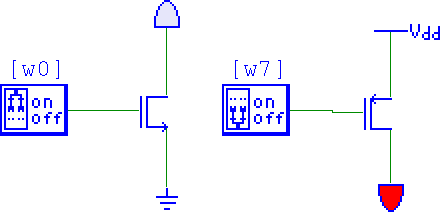Beginning Material
- If you don't know the SI units, learn them!
- Keep in mind: Reliability, Energy Consumption, Speed and Size
- History of Computing
- This is a reasonably nice History of Computing on line.
- The first two sections discuss ancient machines, including
- The abacus
- Napier's Bones, and Slide Rules
- Pascal's machine
- Punched cards and Jacquard's loom
- Babbage's Analytical and Difference Engines
- Note Babbage had a Memory, CPU and I/O
- It was programmable
- Hollerith cards and the birth of IBM
- Part three discusses the MARK I
- This was a mixture of electronics (switches, relays)
- And mechanical (50 ft rotating shaft, clutches and gears)
- Driven by a 5 hp motor.
- Weight 5 tons
- 8 ft tall by 51 ft long.
- Some Supplemental information
- Could store 72 numbers 23 decimal digits long.
- three +/- operations in a second
- × took 6 seconds
- Division 15.3 seconds
- Trig Functions over a minute
- And the ABC by John Atanasoff at Iowa State
- Had memory
- But was not truly programmable.
- Chapter 4, ENIAC (Electronic Numerical Integrator and Calculator)
- Mauchly and Eckert at University of Pennsylvania
- 1943 to 1945
- 18,000 vacuum tubes
- 20 by 40 ft room
- 20 tons
- "The idea that 18,000 tubes could function together was considered so unlikely that the dominant vacuum tube supplier of the day, RCA, refused to join the project (but did supply tubes in the interest of "wartime cooperation")."
- "Even with 18,000 vacuum tubes, ENIAC could only hold 20 numbers at a time. However, thanks to the elimination of moving parts it ran much faster than the Mark I: a multiplication that required 6 seconds on the Mark I could be performed on ENIAC in 2.8 thousandths of a second. ENIAC's basic clock speed was 100,000 cycles per second."
- Programming required physical modification, via patch cords, of the machine.
- Army ad from Null book.
A side note on vacuum tubes
- A vacuum tube has two inputs.
- A cathode, which takes an electric current
- A Grid
- and one output (The Anode)
- A weak signal applied to the Grid amplifies the input from the Cathode to the Anode (IE turns the switch on)
- A strong signal applied to the Grid stops stops the flow of electricity from the Cathode to the Anode
- It is, in essence, an electronic switch.
- Look at page 26, figure 1.11 in the book.
- Electro-Mechanical devices, such as Mark I and ABC were the zero generation
- Vacuum tube machines were the first generation of computers.
- Reference now switches to Null and Lobur
- Transistors: transfer resistor
- A solid-state version of the vacuum tube
- solid-state because it does not involve any air (or lack of)
- Built from silicon or germanium, or ... and aluminum or gallium or ...
- A base and a emitter for input
- An collector for output
- Two types, NPN and PNP
- in an NPN, a ground is connected to the emitter
- If a charge is applied to a base, then the collector
emits a negative charge.
- In a PNP, a source is connect to the emitter
- If a charge is applied to the base, then a positive
charge is not emitted from the collector
-

- The second generation of computers were constructed from individual transistors.
- $10million CDC 660
- 10 million instructions per second
- 128 Kilowords of main memory
- Integrated circuits
- Technology was developed to enable multiple transistors to be be placed on a single chip.
- This is the integrated circuit, or microchip.
- SSI - Small Scale Integration: tens of transistors per chip
- MSI - Medium Scale Integration: hundreds
- LSI - Large Scale Integration: Tens of thousands
- Decreased distance between transistors
- Third Generation
- VLSI, ULSI
- Fourth Generation
